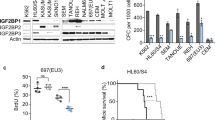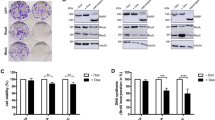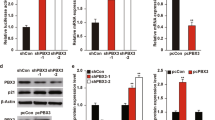Abstract
We showed earlier that cellular retinol-binding protein (CRBP) expression is downregulated in a subset of human breast cancers. We have now investigated the outcome of ectopic CRBP expression in MTSV1-7 cells, a SV40 T antigen-transformed human breast epithelial cell line devoid of endogenous CRBP expression. We found that: (i) CRBP did not inhibit adherent cell growth but suppressed foci formation in post-confluent cultures and colony formation in soft agar; (ii) this effect was due to CRBP inhibition of cell survival, as demonstrated by viability and TUNEL assays of cells in soft-agar or plated on polyHEMA-coated dishes; (iii) CRBP inhibited protein kinase B/Akt activation in cells in suspension but not in adherent cells and the CRBP suppression of anchorage-independent growth was mimicked by cell treatment with the phosphatidylinositol-3 kinase (PI3K) inhibitor LY294002; (iv) CRBP enhanced retinyl ester formation and storage but did not regulate retinoic acid synthesis or retinoic acid receptor activity. Ectopic CRBP-mediated inhibition of anchorage-independent cell survival and colony formation in the absence of significantly altered responses to either retinol or retinoic acid was also documented in T47D human breast cancer cells. In conclusion, the data suggest two novel and linked CRBP functions in mammary epithelial cells: inhibition of the PI3K/Akt survival pathway and suppression of anchorage-independent growth.
This is a preview of subscription content, access via your institution
Access options
Subscribe to this journal
Receive 50 print issues and online access
$259.00 per year
only $5.18 per issue
Buy this article
- Purchase on Springer Link
- Instant access to full article PDF
Prices may be subject to local taxes which are calculated during checkout




Similar content being viewed by others
References
Arapshian A, Kuppumbatti YS, Mira-y-Lopez R . 2000 Oncogene 19: 4066–4070
Bartek J, Bartkova J, Kyprianou N, Lalani E-N, Staskova Z, Shearer M, Chang S, Taylor-Papadimitriou J . 1991 Proc. Natl. Acad. Sci. USA 88: 3520–3524
Brockman JA, Gupta RA, Dubois RN . 1998 Gastroenterology 115: 1049–1055
Busch C, Sakena P, Funa K, Nordlinder H, Eriksson U . 1990 Methods Enzymol. 189: 315–324
Chang TH, Szabo E . 2000 Cancer Res. 60: 1129–1138
Dawson MI, Chao W-R, Pine P, Jong L, Hobbs PD, Rudd CK, Quick TC, Niles RM, Zhang X-K, Lombardo A, Ely KR, Shroot B, Fontana JA . 1995 Cancer Res. 55: 4446–4451
Folli C, Calderone V, Ottonello S, Bolchi A, Zanotti G, Stoppini M, Berni R . 2001 Proc. Natl. Acad. Sci. USA 98: 3710–3715
Frisch SM, Francis H . 1994 J. Cell. Biol. 124: 619–626
Ghyselinck NB, Bavik C, Sapin V, Mark M, Bonnier D, Hindelang C, Dierich A, Nilsson CB, Hakansson H, Sauvant P, Azais-Braesco V, Frasson M, Picaud S, Chambon P . 1999 EMBO J. 18: 4903–4914
Gillies RJ, Didier N, Denton M . 1986 Anal. Biochem. 159: 109–113
Glatz JFC, van der Vusse GJ . 1996 Prog. Lipid Res. 35: 243–282
Huynh HT, Larsson C, Narod S, Pollak M . 1995 Cancer Res. 55: 2225–2231
Jing Y, Waxman S, Mira-y-Lopez R . 1997 Cancer Res. 57: 1668–1672
Kuppumbatti YS, Bleiweiss IJ, Mandeli JP, Waxman S, Mira-y-Lopez R . 2000 J. Natl. Cancer Inst. 92: 475–480
Li G, Fridman R, Kim HR . 1999 Cancer Res. 59: 6267–6275
Liu Y, Lee MO, Wang HG, Li Y, Hashimoto Y, Klaus M, Reed JC, Zhang X . 1996 Mol. Cell Biol. 16: 1138–1149
Lu Y, Lin YZ, LaPushin R, Cuevas B, Fang X, Yu SX, Davies MA, Khan H, Furui T, Mao M, Zinner R, Hung MC, Steck P, Siminovitch K, Mills GB . 1999 Oncogene 18: 7034–7045
Mira-y-Lopez R, Zheng WL, Kuppumbatti YS, Rexer B, Jing Y, Ong DE . 2000 J. Cell. Physiol. 185: 302–309
Napoli JL . 1999 Biochim. Biophys. Acta 1440: 139–162
Pappas R, Newcomer M, Ong D . 1993 Biol. Reprod. 48: 235–247
Ruff SJ, Ong DE . 2000 FEBS Lett. 487: 282–286
Rytomaa M, Martins LM, Downward J . 1999 Curr. Biol. 9: 1043–1046
Sapi E, Flick MB, Tartaro K, Kim S, Rakhlin Y, Rodov S, Kacinski BM . 1999 Cancer Res. 59: 5578–5585
Seewaldt VL, Johnson BS, Parker MB, Collins SJ, Swisshelm K . 1995 Cell Growth Diff. 6: 1077–1088
Shi YE, Ni J, Xiao G, Liu YE, Fuchs A, Yu G, Su J, Cosgrove JM, Xing L, Zhang M, Li J, Aggarwal BB, Meager A, Gentz R . 1997 Cancer Res. 57: 3084–3091
Sun G, Porter W, Safe S . 1998 Mol. Endocrinol. 12: 882–890
Vogel S, Mendelsohn CL, Mertz JR, Piantedosi R, Waldburger C, Gottesman ME, Blaner WS . 2000 J. Biol. Chem. 276: 1353–1360
Wang HL, Kurtz A . 2000 Oncogene 19: 2455–2460
Yamamoto M, Drager UC, Ong DE, McCaffery P . 1998 Eur. J. Biochem. 257: 344–350
Yu W, Bozza PT, Tzizik DM, Gray JP, Cassara J, Dvorak AM, Weller PF . 1998 Am. J. Pathol. 152: 759–769
Yu W, Cassara J, Weller PF . 2000 Blood 95: 1078–1085
Acknowledgements
We thank Joyce Taylor-Papadimitriou (MTSV1-7 cells), Pierre Chambon (pSG5.mCRBP) and M Klaus (Ro 41-5253) for reagent gifts; Dave Ong for sharing his laboratory for the HPLC analyses; Scott Henderson and Vladimir Protopopov for the electron microscopy; Yongkui Jing for his initial contribution to this study; and Eduardo Farias and Liliana Ossowski for helpful discussions. This work was supported by NIH grant CA54273, The Samuel Waxman Cancer Research Foundation and The Norman and Rosita Winston Foundation; Brent Rexer was supported by NIH grants R01DK32642 and 5T32HD07043 to David Ong.
Author information
Authors and Affiliations
Corresponding authors
Rights and permissions
About this article
Cite this article
Kuppumbatti, Y., Rexer, B., Nakajo, S. et al. CRBP suppresses breast cancer cell survival and anchorage-independent growth. Oncogene 20, 7413–7419 (2001). https://doi.org/10.1038/sj.onc.1204749
Received:
Revised:
Accepted:
Published:
Issue Date:
DOI: https://doi.org/10.1038/sj.onc.1204749
Keywords
This article is cited by
-
Cellular retinol-binding protein 1: a therapeutic and diagnostic tumor marker
Molecular Biology Reports (2023)
-
Enhanced sensitivity to androgen withdrawal due to overexpression of interleukin-6 in androgen-dependent human prostate cancer LNCaP cells
British Journal of Cancer (2009)
-
Down-regulation of retinol binding protein 5 is associated with aggressive tumor features in hepatocellular carcinoma
Journal of Cancer Research and Clinical Oncology (2007)
-
Cellular retinol-binding protein-I inhibits PI3K/Akt signaling through a retinoic acid receptor-dependent mechanism that regulates p85–p110 heterodimerization
Oncogene (2005)



